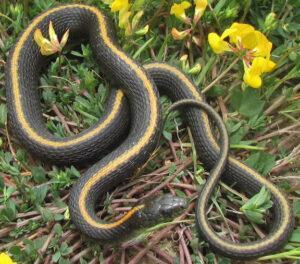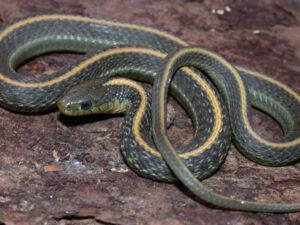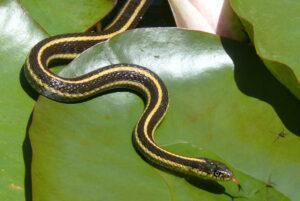
The aquatic garter snake is a colubrid snake that is closely related to an aquatic habitat. It is native to the western United States and is an expert at escaping.
Scientific Classifications
- Suborder:Serpentes
- Family:Colubridae
- Genus:Thamnophis
- Species:T. atratus
Conservation Status
Subspecies and Morphs
This snake has three recognized subspecies.
- Santa Cruz garter snake (Thamnophis atratus atratus)
- Oregon garter snake (Thamnophis atratus hydrophilus)
- Diablo Range garter snake (Thamnophis atratus zaxanthus)
There are two colored morphs of the aquatic garter snake. One has a blue-gray background with a faint olive dorsal stripe and white dots along the sides. Another has a yellow dorsal stripe with black marks along its sides.
Description
Size

The adults of this species grow to a length of 18-40 inches (46-102 cm).
Color and Appearance
The dorsal color of the snake varies a lot. They can be dull gray with alternating rows of darker blotches at the sides, dark brown with indistinct borders, or almost entirely black. A long yellow stripe traversing the dorsum may be present, absent, confined only to the neck, or poorly defined. Their throats and bellies are yellow or whitish.
Are They Dangerous to Humans
On being threatened, the snake takes shelter in a nearby source of water. It is harmless to humans since it is non-venomous.
Aquatic Garter Snakes at a Glance
Distribution
It lives exclusively along the Oregon coast and in California.
Habitat
The aquatic garter snake is most commonly found on the edges of woodlands, brushlands, grasslands, and forests near marshes, ponds, streams, and lakes.
It basks on vegetation and boulders mid-stream and along banks. It takes cover under rocks and among exposed tree roots underwater. Though it is closely tied to water bodies, sometimes individuals can travel long distances over land.
Lifespan
The aquatic garter snake lives for 4-5 years.
Predators
Hawks, herons, crows, cranes, egrets, raccoons, otters, and other snakes (such as kingsnakes and coral snakes) eat these snakes.
Diet
It eats fish, toads, salamanders, and newts.
It quickly grabs its food with its mouth and swallows it whole. In shallow water, it circles its prey and strikes it when it tries to escape. Occasionally, when foraging in a stream, it flicks its tongue above the water surface to make it look like an insect small fish eat, thereby luring its prey into its mouth.
Reproduction
Ovoviviparous (gives birth to live young from eggs that hatch inside the body)
3-12 young form a brood. Though the litter size is small, it can have several litters in a year.
Source
inaturalist.ca, srelherp.uga.edu






